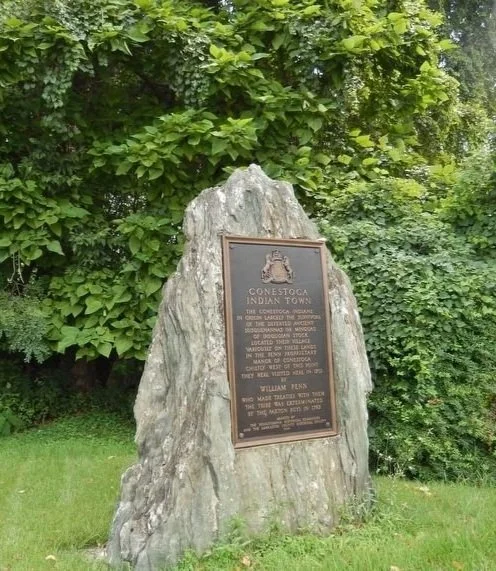In 1763, as tensions hit a boiling point with the outbreak of Pontiac’s war, our people were once again used as a scapegoat for anti-Indigenous sentiments. While our people had nothing to do with Pontiac, an Ottawa chief, and had remained neutral and peaceful in the previous French and Indian war, the community at Conestoga was targeted by religious zealots and marauders known as the Paxton boys. The Paxton boys, who viewed Native Americans as “Canaanites” to be exterminated, would raid Conestoga town on December 14th 1763, just two weeks following pleas from the community for protection from settlers who began to encroach on the land set aside for them by treaty.
The raid on December 14th resulted in the death of all those present at Conestoga town, which were six of the residents. The remaining 14 had been away from the town at the time and survived this initial attack. Below are the names of those six who were murdered at the town itself.
Sheehays
Ess-canesh (son of Sheehays)
Wa-a-shen (George)
Tee-Kau-ley (Harry)
Tea-wonsha-i-ong (an Elder)
Kannenquas
The remaining 14 were housed at a workhouse in Lancaster for their protection. When they were taken into custody, an inventory of their belongings was taken. It included the Articles of Peace and Friendship that had been signed with Maryland nearly a century earlier, signifying the importance of that relationship and the possibility that they intended to return to their old Maryland allies one day. Two wampum belt treaties that have not been recovered were also among those items. The Paxton boys, being dissatisfied at not accomplishing the total extermination of the Conestoga people marched into Lancaster on December 27th, and were not prevented from brutally slaughtering the remaining 14 men, women, and children. Graphic accounts of this affair describe children as young 2-3 years old being slaughtered beside their parents, an act which was never punished. Those 14 murdered that day were:
Koweenasee (Betty)
Kyunqueagoah (Captain John, husband of Koweenasee)
Quaachow (Little John, child of Koweenasee and Kyunqueagoah)
Kanianguas (Molly)
Tenseedaagua (Bill Sack, husband of Kanianguas, source of Mingo language records)
Chee-na-wan (Peggy)
Saquies-hat-tah (John Smith, husband of Chee-na-wan)
Shae-e-kah (Jacob, a child)
Ex-undas (Little Sheehays, son of Sheehays)
Tong-quas (Chris, a child)
Hy-ye-naes (Little Peter, a child)
Ko-qoa-e-un-quas (Molly, a child)
Karen-do-uah (an infant)
Canu-kie-sung (Peggy, a child)
We encourage readers to take a moment to reflect on the lives that were lost that day. Their descendants would have numbered well-over 100,000 today. The stories they would have told, the songs they would have sung, and the relationships they would have formed with the modern communities of York and Lancaster are forever lost. While the Conestoga massacre is often cited as the end of our people, it is rare to hear the names of those killed. We invite you to speak them and consider their lives as husbands, mothers, and children.
From this point forward, the prevailing narrative of our tribe has been one of extinction despite documented evidence to the contrary. This narrative was all too convenient for the emerging colony of Pennsylvania, who integrated the land in short order to private citizens, many of whom were already encroaching on that land prior to the massacre, and stood to benefit from the eradication of Native peoples, who had made great sacrifices to maintain their communities and uphold their treaty commitments.

